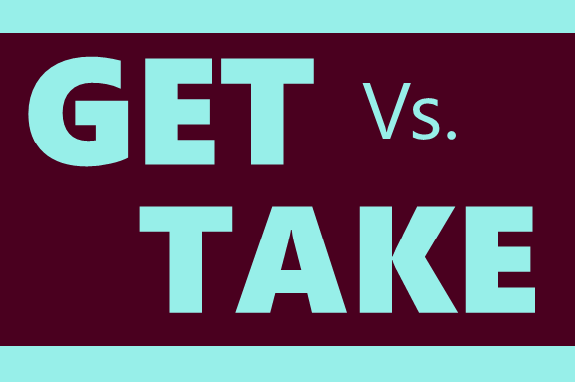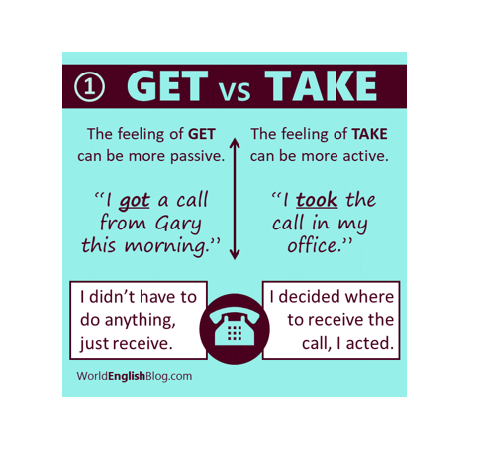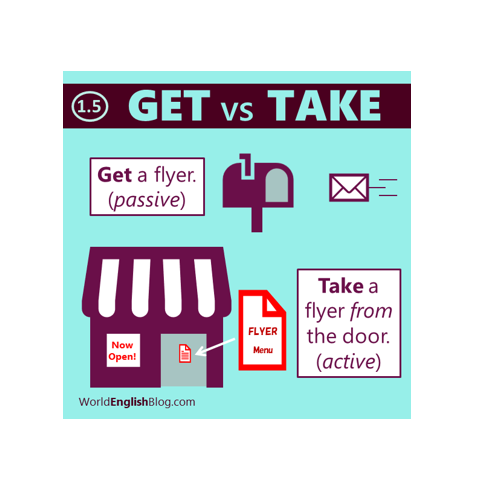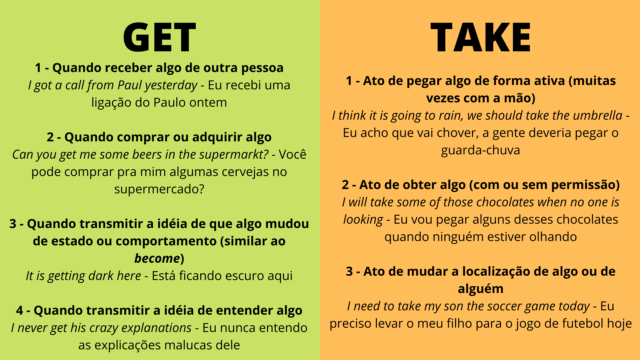
This is a question shared by many English learners.
The main difference between these two words concerns ‘who’ is performing the action.
Get is passive, and take is an active verb.
But I suggest you check the Verbo “to get” lesson first.
The following video shows a few main points to start with. Make sure to take notes! 😉
GET means to gain possession of something. Is a more casual (common) way of saying “obtain” or “receive”.
Get can be used when another person (or thing) gives you something. This is more passive.
I got a call from Gary this morning.
(I received a call from Gary this morning. This is passive, I just received the call.)
Ellen got the new bike on her birthday.
TAKE means to move or carry something from one place to another.
Ellen takes her new bike everywhere she needs to go.
Take doesn’t always need another person (or thing). Something can be taken by a single person in the sentence.
I took the call in my office.
(I accepted/received the call in my office. This is more active, I decided where to accept the call. I am also the only person in this sentence.)

Let’s look at another example:
There is a new Italian restaurant near my office. I got a flyer this morning. The restaurant looks good.
– This sentence is passive, we don’t know how I received the flyer, maybe someone gave it to me, or maybe it came in the mail. We only know that I have it, I received it.
Compare:
There is a new Italian restaurant near my office. I took a flyer this morning from the front door. The restaurant looks good.
– This sentence has an active feeling, we know how I received the flyer and we know what I did to receive it. I took it from the front door. The flyers were offered and I accepted one.

Take can sometimes have a negative feeling
You can take something that is offered to you, like a flyer, some food, etc. This is to accept something. But…
If you remove something that is not offered to you we still use the verb take, but the meaning is negative. This can mean stealing:
Someone took my bicycle from the park. (Someone stole my bike.)
Or it can be a mistake:
I left the house in a rush this morning and I took my wife’s keys by accident. (I grabbed my wife’s keys by mistake.)
Compare:
I got $20 from my Dad for helping him clean the garage. My Dad gave me the money.
I took $20 from my Dad’s wallet. I stole $20 from my Dad. I removed $20 without permission.
Take can also suggest to gain possession of something by force, illegally or unfairly. Then it is similar to verbs like “seize” and “capture”.
The military took control of the country after the soldiers rebelled.
Take is also often used more idiomatically (cannot be understood from the meanings of its separate words but that has a separate meaning of its own) as well, in providing directions to a place. For example:
Jack’s store is on Robbins Road. Take 4th Street for a mile and you will see it.
In that case, take means “use” or “follow”.
Confusingly, take can also be used similar to the verb “give”, like in this sentence:
Michael takes care of Jennifer’s dog.
In that case, the speaker means Michael is the person responsible for meeting the dog’s needs. He is the caregiver to the dog.
Finally, take is often used in connection with expressions of time. For example:
Ellie takes 30 minutes to get ready for work.
That sentence has the exact same meaning as Ellie spends 30 minutes to get ready for work.
Get also is common to idiomatic expressions. It often substitutes for “understand” and “know” (check out the Verbo “to get” lesson). Look at this sentence:
I get that we have to learn math but I do not like it.
Sometimes that usage clearly suggests a speaker’s impatience or frustration:
“I get it, Mom! I have to clean my room today.”
Finally, get is a common substitute for “feel”, “become”, or “start”, among others (check the Adjectives for feelings lesson). Here are some examples:
I’m going to leave for lunch when I get hungry.
She gets sad on rainy days.
He left the show when the music got loud.
There are many more idiomatic uses of get and take. Look for them whenever you get to practice your English! Hehe…
Below is a chart to help you with all this information.

What you have to understand is that both get and take are very common verbs in the English language and they are used with hundreds of different expressions.
The best thing that you can do is recognize when an expression uses get or take, understand how that expression is being used, practice the expression, get comfortable with it and add it to your speech.
It’s more effective to simply learn get or take in a natural context when you see them, when you’re listening to TV, when you’re watching a movie, when you’re reading a book and add it to your vocabulary after a lot of practice and repetition.
For some practice, work on a quiz about get and take.
